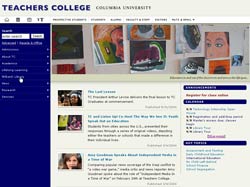Weaving a Better Web
Teachers College's Web site is getting a makeover. Far from settling for the kind of blink-and-you'll miss it cosmetic changes favored by reality television, however, TC's Web team has spent a year and a half working to turn the site into a powerful, universally accessible tool that's as effective as it is attractive. The new site will go live on September 23, 2004.
The effort has been led by Web Editor Paul Acquaro with assistance from Associate Web Editor David Boxer, Web Developer Brenda Lopez, ILT Webmaster Guillermo Crues, and Computing and Information Service's Mike Slaven. It is the first major site overhaul since 1999, and the team has been assisted by frequent consultations with an advisory board consisting of faculty, administration and students.
The site will give a consistent design and feel to the College's Web presence, said Acquaro, allowing users to navigate an intuitive system. To that end, the site has been designed to be fully compliant with useful modern Web standards such as Extensible Hypertext Markup Language (XHTML) and Cascading Style Sheets (CSS), which allow users of modern browsers and of alternative browsing methods to get the same information. "Most of all," said Acquaro, "we want a site that's useable for everyone, internal to the school or not. We want a tool that presents the school well."
The old site "had done quite well," said Acquaro, "but it was stretched to its limits." As many new sites were added to the TC Web, many felt that useful information was hidden behind a maze of links to idiosyncratic pages.
In contrast, the redesigned site provides a "unified look and feel," according to Acquaro. For example, under a "Research" heading, one will now be able to find links to research centers, the library and relevant faculty research or resident experts on a topic. Topic-headings for faculty research will also be intuitively obvious to site visitors who are not intimately acquainted with the College.
In addition to a redesigned site, the Web office has created a new content-management system to make updating Web pages easier. This system functions as a number of standardized site templates that site editors can fill with information. "Faculty members can present online information more easily," said Boxer. "Members of the community can let others know about events more easily. Content is locally controlled but shared in a centralized way."
As part of the redesign, news from around the College will be featured on the front page, and it will be easier to find past articles by date or topic. The External Affairs office will use this site to get stories to the public more quickly and easily. Stories will usually be published to the Web first.
Acquaro sees the change, which is being implemented to coincide with the beginning of the 2004-2005 school year, as just the end of the first phase of development. The school's home page-www.tc.edu-and the links that branch out from it have been redesigned, but there is still a lot of work left to do.
The Web group will continue to meet with the Web advisory board for reactions to the new site, and will eventually bring the numerous department pages into the fold as well. Much of the work that was performed, however, has laid the groundwork for future plans. "We feel we've created a very flexible framework that will make it easier to hook other sites in," said Acquaro.
Acquaro and Boxer say they're excited to present the new site, but will not rest on their laurels. "It's the nature of the beast, that there is going to be a lot of tweaking," said Acquaro.
Published Wednesday, Sep. 22, 2004
